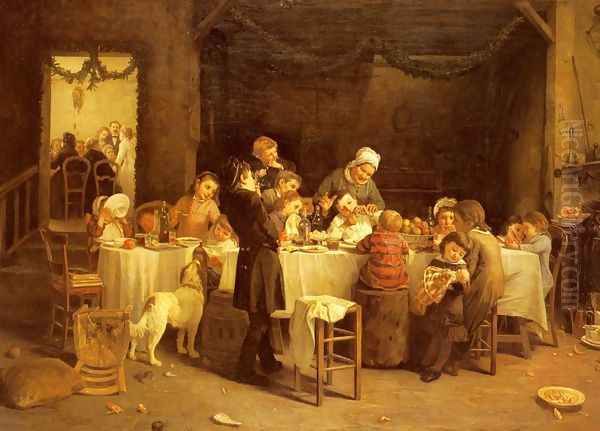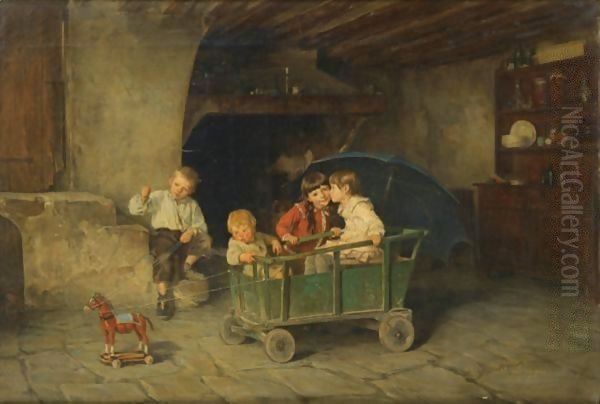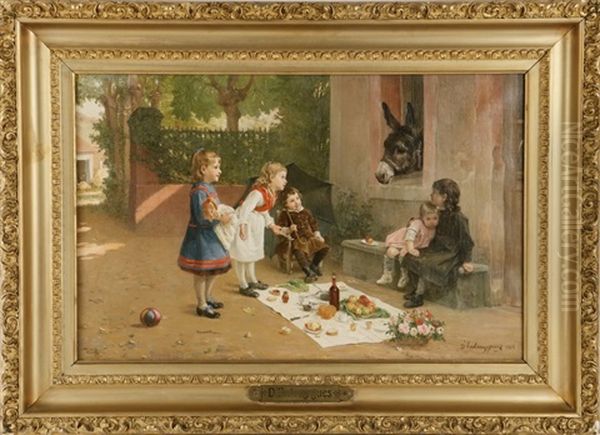Charles Bertrand d'Entraygues (1850-1929) was a distinguished French painter whose artistic legacy is firmly rooted in his charming and insightful depictions of childhood. Working primarily in the latter half of the 19th century and the early 20th century, d'Entraygues carved a niche for himself by capturing the innocence, playfulness, and everyday moments of children, often set against the backdrop of French provincial life. His work, characterized by a gentle naturalism and a keen observational eye, found favor with both the public and critics, securing him a notable place among the genre painters of his era.
Early Life and Artistic Awakening
Born in Brive-la-Gaillarde, a commune in the Corrèze department in central France, in 1850, Charles Bertrand d'Entraygues grew up in a region rich with rural traditions and the unhurried pace of country living. This early environment likely provided a deep well of inspiration for his later artistic focus on simple, everyday scenes. His family, the d'Entraygues, had historical roots in the region, reportedly possessing various lordships and castles in earlier centuries, though their prominence had waned by the 13th century. This connection to a storied past, however distant, might have subtly informed his appreciation for enduring, traditional ways of life.
Recognizing his artistic inclinations, d'Entraygues journeyed to Paris, the undisputed center of the art world in the 19th century. There, he enrolled at the prestigious École des Beaux-Arts, the leading art institution in France. The École was renowned for its rigorous academic training, emphasizing drawing from classical sculpture and the live model, and instilling a respect for the masters of the past. Artists like Jean-Auguste-Dominique Ingres and Eugène Delacroix had shaped its traditions, and by d'Entraygues's time, figures such as Jean-Léon Gérôme and Alexandre Cabanel were influential professors, upholding the academic standards that dominated the official Salons.
Under the Tutelage of Isidore Pils

At the École des Beaux-Arts, d'Entraygues had the significant opportunity to study under Isidore Pils (1813-1875). Pils was a respected academic painter, known for his historical and military scenes, as well as poignant depictions of contemporary life, particularly those reflecting hardship and poverty. He had gained fame for his paintings of the Crimean War and later documented the Siege of Paris during the Franco-Prussian War. Pils was also a dedicated teacher, and despite suffering from ill health in his later years, he continued to guide his students.
The influence of Pils on d'Entraygues might not be immediately apparent in terms of subject matter, as d'Entraygues gravitated towards more lighthearted and domestic themes. However, Pils's emphasis on careful observation, solid draftsmanship, and the ability to convey human emotion and narrative would have been foundational aspects of his teaching. Pils himself was a student of François-Édouard Picot, another prominent academic painter, thus connecting d'Entraygues to a lineage of French academic tradition. The dedication Pils showed to his art, even in adversity, could also have served as an inspiring example of artistic commitment.
Developing a Signature Style: The Charm of Genre
D'Entraygues's artistic voice truly emerged in the 1880s as he began to specialize in genre scenes, with a particular emphasis on the world of children. His approach was marked by a delightful blend of influences. He drew from the humorous and keenly observed tradition of Dutch Golden Age genre painters like Jan Steen or Adriaen Brouwer, who excelled at capturing the lively, sometimes chaotic, reality of everyday life. Simultaneously, his work echoed the narrative clarity and often sentimental charm found in 18th-century French painters such as Jean-Baptiste-Siméon Chardin, known for his intimate portrayals of domesticity and childhood, and Jean-Baptiste Greuze, whose moralizing genre scenes often featured expressive children.
D'Entraygues's paintings were typically modest in scale but rich in detail and character. He possessed a remarkable ability to capture the fleeting expressions and natural postures of children absorbed in their games, their meals, or their quiet moments of contemplation. His compositions were carefully constructed, leading the viewer's eye through the scene and highlighting the interactions between his young subjects. His palette was generally warm and inviting, contributing to the overall sense of comfort and nostalgia that pervades his work. This focus on accessible, heartwarming themes resonated strongly with the tastes of the burgeoning middle-class art market of the Third Republic.
Salon Success and Celebrated Works

The Paris Salon, the official art exhibition of the Académie des Beaux-Arts, was the primary venue for artists to gain recognition and patronage in the 19th century. D'Entraygues began exhibiting at the Salon regularly, and his charming depictions of children quickly garnered positive attention. One of his early notable successes was Le Marchand pourvoire (The Purveyor Merchant), exhibited in 1879.
A pivotal work that cemented his reputation was La table des enfants (The Children's Table), showcased at the Salon of 1882. This painting, depicting a group of young children gathered around a dining table, perhaps for a special meal or a simple daily repast, perfectly encapsulated his strengths. The individual personalities of the children, their interactions, and the carefully rendered details of their attire and surroundings demonstrated his skill in narrative genre painting. The work was praised for its blend of Dutch humor and French narrative grace, becoming a signature piece for the artist.
Another well-regarded painting is Children Playing, a theme he revisited in various compositions. These works often depicted children engrossed in imaginative games, their faces alive with concentration and joy. The universal appeal of such scenes, rendered with d'Entraygues's characteristic warmth and technical skill, made them highly sought after. His ability to convey the unselfconscious absorption of children at play was a hallmark of his art.
Further acclaim came with works like La music adoucit les moeurs (Music Softens Manners), also known as Adieu aux mœurs adoucies, which received an honorable mention at the Salon, reportedly in 1899 or 1901 (sources vary slightly on the exact year of the award for this specific title, though he did receive honors). This title itself suggests a scene where the gentle influence of music, perhaps played by or for children, brings a sense of harmony and refinement. Another piece, Au clair de la lune (By the Light of the Moon, or possibly Moonlight Spring), also earned an honorable mention, showcasing his versatility in capturing different moods and settings. The Parade is another example of his engaging portrayals of childhood activities, likely depicting children mimicking a procession or enjoying a local festivity.
The Écouen Connection and Artistic Community

For over two decades, Charles Bertrand d'Entraygues lived in Écouen, a village situated north of Paris. Écouen held a special significance in the 19th-century French art scene as it became the center of the "Écouen School" of painters. This informal group was largely inspired by Pierre-Édouard Frère (1819-1886), a highly successful genre painter who specialized in sentimental and meticulously detailed scenes of peasant life and, particularly, children. Frère's work was immensely popular, both in France and internationally, especially in England and America, praised by critics like John Ruskin.
Living in Écouen placed d'Entraygues within a community of artists who shared similar thematic interests and a commitment to naturalistic representation. Other painters associated with Écouen included Théophile Emmanuel Duverger (1821-1898), who also painted charming scenes of children and family life, often with a narrative or anecdotal quality. The atmosphere in Écouen would have been conducive to the development of d'Entraygues's specialty, providing a supportive environment and likely opportunities for shared learning and inspiration. His long residency there underscores his deep connection to the themes of rural and domestic life that characterized the Écouen School.
Navigating the Artistic Milieu of Late 19th Century France
D'Entraygues practiced his art during a period of immense artistic ferment and change in France. While he adhered to a more traditional, naturalistic style, the art world around him was being revolutionized by Impressionism and Post-Impressionism. Artists like Claude Monet, Pierre-Auguste Renoir, Edgar Degas, Camille Pissarro, and Berthe Morisot were challenging the conventions of the Salon with their focus on capturing fleeting moments, the effects of light and color, and scenes of modern life, rendered with broken brushwork and a brighter palette.
While d'Entraygues's style was distinct from these avant-garde movements, his work found its place within the broader spectrum of 19th-century art. Academic painting, championed by figures like William-Adolphe Bouguereau, Jean-Léon Gérôme, and Alexandre Cabanel, continued to dominate the official Salons with its polished finish and often grand mythological or historical subjects. D'Entraygues's genre scenes, while less grandiose, still aligned with the academic emphasis on skilled draftsmanship and coherent narrative.
His work can also be seen in relation to the Realist movement, which had earlier been spearheaded by Gustave Courbet and Jean-François Millet. While d'Entraygues's depictions of rural life and children were generally more idealized and less overtly critical than the often stark portrayals of the Realists, he shared their interest in depicting ordinary people and everyday existence. His focus, however, was more on the charming and sentimental aspects of life, rather than its hardships. Artists like Léon Augustin Lhermitte and Jules Breton also depicted rural life, often with a sense of dignity and quiet heroism, occupying a space between academic polish and Realist grit. D'Entraygues's niche was the intimate world of childhood, which he explored with a sensitivity that appealed to a broad audience. Mary Cassatt, an American Impressionist working in Paris, also famously depicted mothers and children, but her stylistic approach, influenced by Degas and Japanese prints, was markedly different from d'Entraygues's gentle naturalism.
Themes, Techniques, and Lasting Appeal
The enduring appeal of Charles Bertrand d'Entraygues's art lies in his sympathetic and skillful portrayal of childhood. He avoided overt sentimentality, instead focusing on genuine moments of play, learning, and interaction. His children are not merely idealized cherubs; they are individuals with distinct personalities, captured in moments of unfeigned naturalness. Whether depicting a boisterous game, a quiet moment of shared reading, or the focused concentration of a child learning a new skill, d'Entraygues imbued his scenes with a sense of authenticity.
His technique was characterized by careful drawing, smooth brushwork, and a keen attention to detail in rendering figures, clothing, and settings. He had a fine sense for composition, arranging his figures in a way that created a clear narrative and a harmonious visual balance. His use of light was often soft and warm, enhancing the intimate and inviting atmosphere of his paintings. The humor often present in his works is gentle and affectionate, stemming from a clear fondness for his young subjects.
The commercial success d'Entraygues enjoyed was significant. In the late 19th century, with the rise of an affluent middle class, there was a growing market for art that was accessible, relatable, and aesthetically pleasing. Genre scenes, particularly those depicting the joys of family and childhood, were highly popular. D'Entraygues's paintings, with their combination of technical skill, charming subject matter, and reasonable prices, catered perfectly to this demand. His works were acquired by private collectors in France and, notably, in the United States, where there was a strong appetite for European academic and genre painting. His inclusion in publications like the "Catalogue of the World's Famous Paintings" in 1904 further attests to his international recognition.
Later Life and Legacy
In 1906, after more than two decades in Écouen, Charles Bertrand d'Entraygues left the village. His personal life included his marriage to Caroline Monet (no known relation to the famous Impressionist painter Claude Monet). He eventually settled in Biot, a picturesque village in the Alpes-Maritimes department on the French Riviera, near Marseille. This move to the south of France may have offered new inspirations and a different quality of light, though his primary focus on childhood themes likely remained consistent.
Charles Bertrand d'Entraygues passed away in 1929, leaving behind a substantial body of work that continues to be appreciated for its charm, technical proficiency, and heartfelt depiction of a timeless subject. While he may not have been an avant-garde innovator in the mold of the Impressionists or Post-Impressionists, his contribution to French genre painting is undeniable. He excelled within his chosen specialty, creating images that evoke a sense of nostalgia and celebrate the universal experiences of childhood.
His paintings remain popular in the art market today, frequently appearing at auctions where they command respectable prices. They are valued by collectors who appreciate their aesthetic appeal, historical context, and the enduring charm of his young subjects. Museums with collections of 19th-century European art also hold his works, recognizing their place within the tradition of genre painting.
Conclusion: A Master of Childhood's Gentle Narratives
Charles Bertrand d'Entraygues stands as a significant figure among French genre painters of the late 19th and early 20th centuries. His decision to specialize in scenes of childhood, rendered with a blend of Dutch-inspired humor and French narrative elegance, allowed him to create a distinctive and appealing body of work. Educated at the École des Beaux-Arts under Isidore Pils, and deeply connected to the artistic community of Écouen, he developed a style that was both technically accomplished and emotionally resonant.
His paintings, such as La table des enfants and his many depictions of Children Playing, captured the public imagination and earned him critical acclaim and commercial success. In an era of dramatic artistic shifts, d'Entraygues remained true to his vision, creating art that celebrated the simple joys, the innocent mischief, and the quiet moments of childhood. His legacy is that of a sensitive observer and a skilled chronicler of a world often overlooked by grander artistic ambitions, a world whose charm and truth continue to speak to viewers today. He provided a window into the lives of children, rendered with an affection and understanding that transcends time, securing his place as a beloved painter of childhood's fleeting, precious moments.